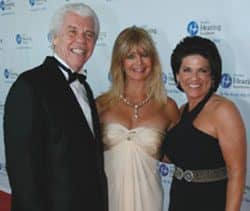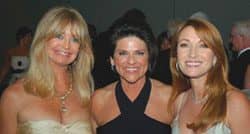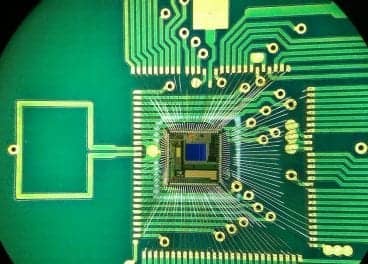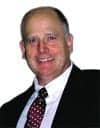
|
Some inventions have made life easier—the automobile and the telephone, for instance. Others have made it more entertaining—such as the television and the roller coaster. Other innovations have focused on increasing productivity—the computer and the cotton gin, for example. And still others have been inspired by sheer necessity—consider sewage systems and most medical devices.
Naturally, there is also a lot of crossover among these categories. Cochlear implants, for instance, may have been inspired by the need to hear, but in turn they can also make life easier, more entertaining, and even more productive.
The invention of the cochlear implant has caused a lot of discussion and debate among those in the hearing and Deaf communities. But when Graeme M. Clark, PhD, FRCS, first invented the electronic, multiple-channel, implantable hearing device, he did so simply to help his father.
Clark, director of the Bionic Ear Institute in Australia, grew up watching his father, a pharmacist and family man, struggle with severe hearing loss. In a 2004 interview, Clark recalled, “[My father] hadn’t a very good hearing aid, and people came into the country town of Camden, where the pharmacy was, and they’d ask for confidential items. Dad would ask them to please speak up. So everyone in the shop knew what they were after. So whenever they came in and I was there, I’d signal to him I heard—I knew what it was. I’d rush to the appropriate drawer and get the items.”1
Inspired to help his father in a more concrete and consistent way, Clarke left a successful medical practice to focus on the development of multichannel cochlear implants. His research resulted in the first successful implant in 1978, and eventually led to the technology behind the device manufactured by Cochlear Limited, which established its global headquarters in Australia in 1981. In 1984, the company established its North American headquarters as Cochlear Americas in Englewood, Colo.
More than 20 years later, the company has manufactured cochlear implants for nearly 90,000 patients. Research has shown that cochlear implant recipients typically hear better. Unfortunately, it has also shown that many patients are unaware of the benefits an implant can provide. To address this, Cochlear Americas is increasing its focus on education for audiologists and potential recipients regarding implants and the value of bilateral implantation. “We believe two ears are better than one, regardless of the configuration,” says Christine Menapace, MA, CCC/A, vice president of clinical regulatory and professional education with Cochlear Americas.
“Necessity may well be called the mother of invention—but calamity is the test of integrity.”
—Samuel Richardson, British novelist
The instrument implanted today has very different electronic capabilities than the first model, but all of Cochlear’s devices incorporate the concept of 22 electrode contacts. “The basic premise of 22 electric contacts has always been the hallmark of Cochlear devices,” Menapace says.
Implanted electric cochlear devices bypass the cochlear area, stimulating the auditory nerve directly. An external sound processor converts sound into digital signals, which are sent to the internal processor. This piece then transforms the signals into electrical impulses, which are transmitted directly to the auditory nerve. Cochlear does this with the 22 electrodes; the increased amount of stimulation is designed to deliver a finer representation of sound.
The device is approved for use in patients older than 12 months. Cochlear received its first FDA approval in 1985 for the Nucleus Mini22 implant with Wearable Speech Processor in patients 18 years and older; the FDA approved its use in children age 2 to 17 in 1990.
“There are some serious medical conditions that could be a contraindication, such as patients whose cochlea is not damaged,” Menapace says, “but there is nothing the general public would need to be concerned about right away.” She notes that the devices have even been implanted in children younger than 12 months at the discretion of audiological and surgical teams. (While there are few contraindications, one thing to remember is that after implantation, patients must be sure to remove the device’s internal magnet before undergoing MRIs.)
The implantation is typically performed by an otologist or ear surgeon trained in inner-ear surgery. Over the past 2 decades, the procedure has become less traumatic, no longer requiring an overnight stay. Because anesthesia is required, many patients are encouraged to rest the day after surgery. Some clinics provide the opportunity for same-day programming, where the processor is turned on the day following surgery, within 24 hours; other clinics may wait as long as 6 weeks after implantation. “Most clinics wait about 2 weeks,” Menapace says.
Aural rehabilitation is recommended for all cochlear implant recipients, but typically much more so for children. “Most children are strongly advised to go through auditory rehabilitation therapy as well as speech and language therapy,” Menapace says. Some type of therapy should be part of a young patient’s long-term-care plan, particularly during the critical language development years.
Older patients may not always opt for therapy, but could still benefit. “Today, many [adults] who get implants don’t have the time or resources for therapy and do pretty well without it. But anyone who does get auditory rehab, even if using tools at home, will get more out of their implant,” Menapace says.
“If necessity is the mother of invention, then resourcefulness is the father.”
—Beulah Louise Henry, US inventor
New features have also increased the value of these devices. Cochlear’s latest implant, the Nucleus Freedom, launched in May 2006, offers internal features that include multiple coding strategies and variable rates of stimulation, permitting greater customization. “It’s easier to match the device to the individual’s hearing fingerprint,” Menapace says.
Externally the device has also improved. The Freedom Audio Processor offers water resistance, two-microphone technology to reduce background noise and amplify conversation, automatic sound-level adjustment, and soft-sound (ie, whispers) enhancement. The processor is also customizable by the audiologist and the individual, who can change settings to fit specific hearing situations, such as quiet or noisy environments.
The Nucleus Freedom is the fourth-generation model of Cochlear’s implant; its pieces are smaller, more reliable, and more advanced than former versions. “All of the implantable models use 22 electrode contacts, but with very different electronic capabilities. Every generation has gotten better in terms of capability and reliability,” Menapace says.
With each advance, however, previous customers are not left behind. “Every time we launch a new processor, which is where many of the new features are offered, we make it compatible with the oldest implants so [long-time] patients can benefit from the newer technology,” Menapace says.
“Sheer necessity—the proper parent of an art so nearly allied to invention.”
—Richard Brinsley Sheridan, Irish playwright
This does not mean that reimplantation is not an option. Some patients decide to upgrade—some following an internal device failure. “Our implant reliability is 99.8% at 2 years,” says Menapace, adding that failures do happen, often in response to serious blows to the head.

|
| All cochlear implants manufactured by Cochlear Ltd use 22 electrodes to transmit electrical impulses directly to the auditory nerve. |
Follow-ups have revealed marked improvement in hearing postsurgery. “We test recipients on a battery of speech and audiometric tests that look at the ability to understand words and/or sentences in both quiet and noisy environments, before and after implantation,” Menapace says. She notes that despite efforts to mimic real-life situations, the tests are conducted in sound booths.
One of the latest Cochlear studies examined adult response among patients receiving implants up to 12 months following surgery. Surveyors found that many patients performed at a high level 3 months postsurgery, but also continued to improve over time. In a test mimicking a real-life quiet environment (60 dB SPL), recipients of the Nucleus Freedom had a mean score of 45% on the CNC (consonant-vowel-consonant) recognition test at 3 months. By 6 months, the mean score for the average patient had risen to 53%, and at 1 year, it was 62%.
“The Freedom device has been the first system ever to show scientific results near a 50% word score in a large group of individuals at 3 months,” Menapace says. “Before Freedom, the mean score had been 38%. In the 1990s, we were happy with a score of 20%.”
“Necessity first mothered invention. Now invention has little ones of her own, and they look just like grandma.”
—EB White, US author and editor
“If a child is implanted and undergoes proper postsurgery rehabilitation, that child could be mainstreamed by the time [he or she] reaches kindergarten, but this awareness is not in the masses or across all layers of the medical profession,” Menapace says. Newborn screening is catching more disorders in infants, but adults are very underserved in the implant market.
“We estimate that one in 10 adult patients who could benefit is actually being treated with implants,” Menapace says. A recent Cochlear study found that the average adult patient has severe to profound deafness for about 12 years before deciding to get an implant.
Part of that delay is because the majority of patients see audiologists whose experience with implants is limited. Menapace estimates that about 350 clinics in the United States perform cochlear implants. But, according to the American Academy of Audiology, Reston, Va, there are an estimated 14,000 audiologists in the United States.
“Most audiologists don’t work with implants, so there is a large gap between the cochlear clinics and where most patients are served. Even those professionals who are aware [of the cochlear implants] will describe it as an aid—to help with lip reading, for instance—when it can really restore hearing,” Menapace says.
As Cochlear works to increase awareness about implants, it is also seeking to increase awareness about bilateral implantation. Menapace estimates that only about one fourth of the 90,000 implant recipients have implanted two cochlear devices. But restoring hearing in both ears—whether with two implants or an implant and a hearing aid, or even two hearing aids—more closely mimics the natural method of human hearing.
“With the first implantations about 25 years ago, we didn’t know what long-term electrical stimulation would do to an individual, so medicine took the conservative approach. But a lot of research begun about 10 years ago shows that a profoundly deaf individual can benefit from a bilateral cochlear implant,” says Menapace, citing localization as an example.
Adding a second implant doesn’t show the huge improvement in test scores that occurs after implantation of one device, but customer satisfaction is high, Menapace says. “Some of this is [because] we haven’t developed sensitive enough audiological tests to measure the benefit, but patients report huge benefits and satisfaction when out in the real world,” she says.
Looking ahead, the company is developing hybrid technology that is partially implanted in the cochlea and provides electric and acoustic stimulation. Currently in clinical trials, the device is intended for patients who have severe to profound high-frequency hearing loss, but normal hearing at low frequencies. “About 90 patients have been implanted with this technology, and early results show they tend to do better with the new devices than when wearing two hearing aids,” Menapace says.
As Cochlear focuses on research and development, it continues to provide solutions to patients in need. “We like to say that, in the United States, every day we help more than 125 people hear what they would not hear without Cochlear technology,” Menapace says.
REFERENCE
- Clark G. How he came to invent the cochlear implant [transcript]. “George Negus Tonight.” ABC Australia television. May 27, 2004. Available at www.abc.net.au/gnt/profiles/Transcripts/s1117832.htm. Accessed on June 13, 2007.
Renee DiIulio is a contributing writer for Hearing Products Report. For more information, contact [email protected].





